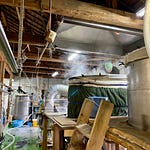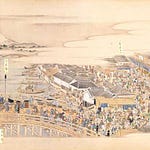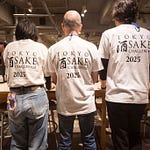Welcome to Issue#138 of SIN.
The weather is heating up, the rainy season is coming (or is it already here?) and rice is being planted. However it won’t be enough.
The rice shortages continue as the government scrambles to deliver stockpiled rice to communities around the country. The government has also acknowledged the wider reach of the rice shortage as it announced plans to share some of its precious stash with rice-using industries which are in desperate need of a few grains. Furthermore, based on rumors to which we at SIN are privy, some prefectures are considering financially assisting breweries to help pay for rice. Not sure how true it is, but it is both good news that it might happen, yet unfortunate that it is necessary.
And now for the news…
Sake Sinks (but in a good way)
Fukui- It’s been a while since we saw one of these projects, but it’s still fun to see the experimental spirit alive and well. This month in the Kawano region of Minamiechizen in Fukui Prefecture, a group of local volunteers from the fishing and food service industries launched an experimental project hoping to encourage local interest in sake by aging a number of bottles of sake on the seabed off the coast of the region. Once retrieved the team look forward to assessing the effects of what they described as the “ocean cradle,” in inducing smooth mellowness in the sake.
The team believes that the seabed’s stable temperature and the gentle motion of the current contribute to create a unique flavor profile. Members of the project have studied similar efforts in other areas such as Himi City in Toyama Prefecture.
Local sake producers Horiguchi Shuzō (Nari Hisago), Kitazen Shōten (Hokurikukaidō Imasho Juku) and Hatakeyama Shuzō (Yuki Kirara) submitted sake they felt would be suitable for such a maturation project.
On June 8, the team gathered at Kawano Fishing Port where they packed a total of 120 720ml bottles from the three breweries into beer crates. With help from the local fishing co-op, the crates were transported about 200 meters offshore and gently submerged to a depth of around 15 meters using a crane. Half of the sake will be matured for three months, and the remaining half for six months. An additional 60 bottles will be submerged in August as part of a new aging cycle.
The group plans to organize a tasting event during the “New Soba Harvest Thanksgiving Festival” on November 23 in the Imajō area, where participants will be able to compare the same sake in their unaged, three-month aged, and six-month aged forms. Looking ahead, they are also considering launching a membership-based distribution club for the seabed-aged sake and offering it as a return gift for the town’s hometown tax donation program (furusato nozei).
Listen to this episode with a 7-day free trial
Subscribe to Sake Industry News to listen to this post and get 7 days of free access to the full post archives.










